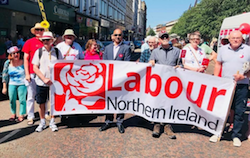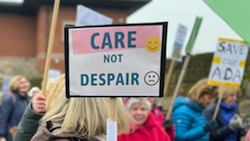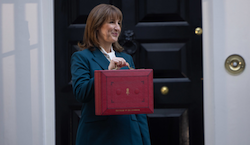Northern Ireland is changing, argues GERARD GALLAGHER, and it’s time for Labour to allow the region’s growing and increasingly relevant party to field its own candidates.
It can sometimes come as a bit of a shock to people to learn that Northern Ireland has a Labour Party – the Labour Party Northern Ireland (LPNI). Our history, in keeping with the rest of Northern Ireland, is complex.
 The first ever Labour Party conference was held in Belfast in 1907 in the Wellington Hotel. From the 1920s through to the 1970s, Labour (or the Northern Ireland Labour Party as it was then known) had a number of MPs at Stormont (they’re now known as MLAs – Members of the Legislative Assembly) and formed part of the official opposition. This was not a small feat given the dominance and gerrymandering of the Unionist Party. Northern Ireland, for all intents and purposes, was a one party state.
The first ever Labour Party conference was held in Belfast in 1907 in the Wellington Hotel. From the 1920s through to the 1970s, Labour (or the Northern Ireland Labour Party as it was then known) had a number of MPs at Stormont (they’re now known as MLAs – Members of the Legislative Assembly) and formed part of the official opposition. This was not a small feat given the dominance and gerrymandering of the Unionist Party. Northern Ireland, for all intents and purposes, was a one party state.
The NILP was pivotal in the formation of the Northern Ireland Civil Rights movement (NICRA) in the 1960s, and indeed, several our current members were very prominent in the NICRA. When the Stormont parliament was suspended in the 1970s Labour’s future was uncertain.
The civil rights movement and its growing association with nationalism heralded the birth of a new party, the SDLP, which for a while promised to be a Labour party but ultimately fell sway to its more nationalist members. Labour fell by the wayside.
Fast forward to 1998 and the Good Friday Agreement. It brought an end to more than 30 years of political violence and armed conflict but ultimately offered no role for the Labour movement, in my view one of the great failings of the peace process. It took a court case and settlement in 2004 for New Labour to allow us to organise again. We were permitted only one CLP for the whole region and, fatefully, no right to field candidates – a death blow for any aspiring political movement.
Nonetheless, part of this settlement was a promise that every parliamentary term Labour HQ would review our right to stand candidates. For one reason or another, this promise was occasionally evaded, and the few that were held were seen by members in Northern Ireland as acts of theatre, intended to avoid potential legal repercussions rather than genuine attempts to engage with a burgeoning Labour movement.
Support & solidarity
We are currently in the process of one such review. Before it started, we set up a working group made up of the different strands of LPNI, representing all its efforts to organise politically and highlighting how deep the Labour movement is in Northern Ireland.
 We termed our new campaign ‘Right2Stand’ and created a website. I stood as a candidate for the NEC elections in 2022. Northern Ireland has 18 Westminster constituencies, but only one CLP. (In the past we would have called this gerrymandering.) Consequently, to get an LPNI candidate onto the ballot we had to approach CLPs in England, Scotland and Wales to endorse us, no mean feat given the crowded field and relatively niche relevance of our campaign to Labour members in Great Britain.
We termed our new campaign ‘Right2Stand’ and created a website. I stood as a candidate for the NEC elections in 2022. Northern Ireland has 18 Westminster constituencies, but only one CLP. (In the past we would have called this gerrymandering.) Consequently, to get an LPNI candidate onto the ballot we had to approach CLPs in England, Scotland and Wales to endorse us, no mean feat given the crowded field and relatively niche relevance of our campaign to Labour members in Great Britain.
Nonetheless, in the finest Labour tradition, we received a lot of support and solidarity from comrades across the political (and dare I say it, factional) spectrum. We were invited to meetings up and down the country and made it onto the ballot, an achievement we were extremely happy about. (There is more about me and my motivation for running on our website.) Both Andy Burnham and Luke Akehurst were guest speakers at our fringe event at last year’s Labour conference, a testament to our broad support across the party.
Following this success, the formal review got underway and Labour HQ gave us six questions to answer. Our full responses to those questions can also be found on the website, but the first is probably the most important: “Should the Labour Party stand candidates in Northern Ireland, what would be the Party’s prospects of electoral success? And what evidence can we rely on to meet your conclusion?”
It seems a fairly straightforward question and it gave many of us in LPNI hope that we were finally being taken seriously. Crucially, it forced us to move out of our comfort zone and prove what we had long suspected – that Northern Ireland is a fertile ground for Labour politics.
We approached the polling company, LucidTalk, which has a long track record of accurately predicting the outcome of NI elections. As you can imagine, we were on tenterhooks waiting for the results but not even the most optimistic of us expected the response. It felt genuinely ground-breaking.
We asked two main questions, slightly paraphrased as: “Should Labour Stand in Northern Ireland?” and “If Labour stood, would you vote for Labour?”.
In answer to the first question, a huge 32% of people said we should stand, with just over half saying ‘no’. Given the highly contested nature of Northern Irish politics, and the crowded field of political parties, finding that a third of the population think we ought to stand is extremely encouraging.
Interestingly, the response to the second question was even more encouraging. Northern Ireland has a proportional representation system which means voters place a ranked preference beside a candidate. You do not need to vote for every candidate and most people tend to cast a preference for three or four.
The poll revealed that we would receive first preference votes from around 6% of the population. In comparison, People Before Profit get around 1.1%, and have several councillors and MLAs, while the Green Party get 1.9% and have an MLA and some councillors. Our polling suggests we have much broader potential support than they have ever obtained.
It also showed that we would receive preferences from around 38% of people. That’s right – 38%! Deeper analysis showed that this support was broadly similar across all NI district council areas, and we would draw voters from all three traditions – unionist, nationalist and ‘other’. (See more detail on the poll data here.)
It is worth reflecting on this point. Historically Northern Ireland has been seen as something of a basketcase, a deeply divided society that’s stuck between two rival camps. This could not be further from the truth. A full discussion of why this is wrong would take many more words than I have space for here, but let’s take a brief look at the most recent election.
When the cross community Alliance Party became the third largest party it was a political earthquake in many respects because it reflected the shift from a divided society to one that’s frustrated with tribal politics. Indeed, surveys and vox pops increasingly show we are moving in this direction.
New generation
I am part of this new generation. I grew up during the tail end of the troubles and witnessed my fair share of conflict. I grew up in a staunchly republican/nationalist area of Belfast, yet I have lived for the last 10 years or so in a staunchly loyalist/unionist part of town. A few of my childhood friends live nearby too. There is very little that separates these communities other than the colour of the murals.
 We are becoming increasingly secular and much more focussed on bread-and-butter issues – no different from the rest of the UK, or indeed Ireland. Northern Ireland is looking to the future, away from sectarian conflict and sectarianised politics. We are concerned about our jobs, our future, the NHS, our children’s education and the growing problems with drug abuse and deaths amongst our young. The shape of our flags matters less and less.
We are becoming increasingly secular and much more focussed on bread-and-butter issues – no different from the rest of the UK, or indeed Ireland. Northern Ireland is looking to the future, away from sectarian conflict and sectarianised politics. We are concerned about our jobs, our future, the NHS, our children’s education and the growing problems with drug abuse and deaths amongst our young. The shape of our flags matters less and less.
What is telling about this most recent set of elections is not only the growth of the colloquial ‘middle ground’, but the lack of any genuine left-wing, labour oriented tradition. Typically, many in Great Britain see the SDLP as a Labour party, but in truth they are nationalist first. People in areas where I live could never countenance voting for them, and indeed even in areas where I grew up their support is dwindling. The SDLP are losing votes and losing seats with each new election. And they do not have any tangible links to the trade union movement, the lifeblood of any Labour party.
Northern Ireland has one of the highest densities of union members of anywhere in the UK. We have over 250,000 trade union members, many of whom pay the political levy to Labour – yet we have no political representation at any level. Many of these unions, including Unite, GMB, USDAW, Community and others, have affiliated directly to LPNI and made submissions to GB Labour advocating for our right to stand candidates.
Outside of the trade union movement, LPNI has a network of activists across the third sector – in housing, health and social care, academia and education, and so on. We have active policy exchanges and have started workshops and liaison groups to develop coherent policy on the issues that matter.
We are in many respects a young and vibrant party held back by an English Labour Party stuck in an outdated, and I’d take the risk to say, neo-colonial view of Northern Ireland. It’s a view rooted in the past that ignores all of the advances of the past 30 years and forces Northern Ireland to be the only place across both islands that has no Labour Party representation.
As for our review, some of our members are cautious – they’ve been down this road before, waiting for Labour to give us basic democratic rights. But I am optimistic. I have seen the breadth of support we have across the Labour movement in the UK, and I have spoken to MPs, councillors and members of the NEC who quietly speak in favour of us but are, understandably, too cautious to say it out aloud.
We held a review meeting just a few weeks ago in Belfast and were questioned about where we thought we could win seats, as well as the implications for the Good Friday Agreement if we start to win councils. This is a far cry from the dismissive tones we’ve heard in the past. On leaving the meeting, we saw our comrades in GMB, excited to make their case for our right to stand.
We are not naive, however, we know this is a tricky issue and we still face an uphill battle. But the LPNI is nothing if not tenacious – we have been fighting this battle for 20 years. With a bit of luck our next battle will be an election.
—-
Gerard Gallagher (pictured above) is a member of LPNI’s executive committee and chair of Right2Stand.
You can read more about the Labour Party Northern Ireland here.
More about the Right2Stand campaign is here.
More detail of LPNI’s polling data is here.
See also: ‘Ireland, the ILP & the Slow Train to Peace’, by Gary Kent.


